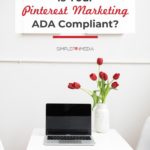How’s that for a dry podcast title — How to Make Your Website ADA Compliant? OK, hear me out friends — if you have a website, you really do need to listen to this episode.
Rather than share a laundry list of boring facts, my guest is going to walk you through exactly what steps you need to take to make sure that your website is 100% compliant with current accessibility laws.
What I want you to promise is that you will listen without allowing yourself to get overwhelmed and then take action on the three steps we give you at the end of the podcast. We’ll break it down very simply, with the exact steps you need to take in order to achieve ADA compliance, depending on where you are in your business.

Andrew Wilder is my guest today. He’s the founder of Nerdpress, a digital agency that provides WordPress maintenance and services for small businesses. While Nerdpress services all types of blogs, they specialize in food blogs.
Before we jump into the episode though, I want to remind you of all the free resources we offer here at Simple Pin.
For starters, we have a free, comprehensive marketing planner that grows and gets better every single year! We also offer a free 8-page Pinterest image guide. In addition, we offer a variety of email training series, based on where you are in your business.
Ready to get started with Pinterest marketing, or are you a beginner? Sign up for our Start newsletter series. If you’ve been in the game for a while and you’re ready to grow, sign up for our Grow newsletter series.
From Food Blogger to Blogging Tech Business
Andrew got started in the online space with a food blog (Eating Rules) back in 2010. As he grew it, he also began to get involved in the food blogger community, attending conferences and helping other food bloggers with their blogs.
What struck me about Andrew is that his process was similar to what we see so often here at Simple Pin. A person starts out pursuing a hobby, they start a blog about their hobby, and before they realize it, they have created an actual business.
Websites and blogs require certain things in order to remain legal. In recent years, the GDPR regulations has thrown many a blogger for a loop, just trying to figure out what it all meant and how to do the right thing in light of it.
In addition to making sure your website complies with GDPR and CCPA regulations, there are even more legal aspects to think about, one of those being accessibility.
Ensuring that your website is in full compliance with current laws can be a full-time job. Do you have to say goodbye to your hobby and hello to a new job? Not necessarily. You can outsource some of these tasks so that you can still focus on the part of website ownership that lights you up — creating the content.
What Is ADA Compliance?
Because of the number of horror stories that center around bloggers trying to figure out GDPR/CCPA, I wanted to interview Andrew on the podcast so that he can explain to us exactly what we need to know about ADA compliance and accessibility for our sites.
Accessibility simply means making sure your website is usable for everyone, including anyone with any disability. There are varying levels of accessibility. The basic ideas is that anyone who wants to consume the content on your website is able to so. For example:
- If the user is visually impaired, they should be able to use a screen reader to navigate the site.
- If they are unable to use a mouse, a reader should be able to navigate the site with their keyboard.
The ADA stands for the Americans with Disabilities Act, which was signed into law in 1990 and applies to all businesses. At its core, it states that every business has to be accessible to everyone.
In the case of brick and mortar businesses, being ADA compliant might include having ramps for wheelchairs or handicapped-accessible restrooms. Recently, there have been some court rulings that suggest that the Americans with Disabilities Act also applies to websites.
What Are the Ramifications if Your Website is Not ADA Compliant?
At this time, there are no government penalties for your site not being 100% accessible or ADA compliant.
So far, the only consequences have been in the private sector, as a few website owners have been taken to court over lack of accessibility. It should be noted that government websites have different rules to follow. As a private blogger or website owner, you don’t fall under those same guidelines.
Your only real problem could be being sued by a person or company who reports that your website is not ADA compliant. If you sell physical products, you need to move quickly and get your game plan in place to be ADA compliant sooner rather than later. If you are more of an information blogger, you don’t have to be quite as fearful of the issue –yet.
What Are the Standards of ADA Accessibility?
As we stated earlier, there are no government guidelines on what standards website owners must meet to be ADA compliant. However, there is a set of standards for ADA compliance that was developed by an online organizational body. It’s important to note that this is not a legal document. These are what would be considered best practices, and they are what the courts are using to consider the outcomes of the lawsuits being filed against websites.
The guidelines describe three levels of compliance:
- A
- AA
- AAA
You should be aiming for AA compliance. If your audience is made up primarily of a group of people who deal with a specific disability, you may need to achieve AAA accessibility.
Let’s look at some of the things you need to consider as you strive to make your website ADA compliant.
1. Alt Text Descriptions
For some time now, Pinterest marketers have used the Alt text description to enter their Pinterest description, but we all know that’s not what that box is for. I asked Andrew to share about the Alt text description and how we should be using it.
Alt text stands for “alternative text.” It is used in the coding of an image tag to provide the description or information in an image or the function of an image (how the image is used.)
An informational image could be a picture inside a blog post. In this case, you would use the Alt text to describe that image for someone who cannot see it. The ramifications of using alt text descriptions inappropriately affect more than just visually impaired readers.
Have you ever been somewhere with a poor connection and instead of seeing an image, you see words in the box where the image should load? You’re viewing Alt text. It’s describing the image that should be viewed.
If a visually impaired person is using a screen reader, the reader will literally read the words in the Alt text to them. Ideally, you’ve included a short, succinct description of the image in the Alt text box, as if you were describing it to somebody with their eyes closed.
Why You Should Never Put Pin Descriptions in the Alt Text Box – Andrew feels very strongly about Pinterest’s longstanding suggestion to utilize the Alt text field for your pin description. He asks you to think about the consequences of doing this from the point of view of a person using a screen reader.
Imagine you’re reading a blog post for a chocolate cake recipe. Every time an image appears, the reader says, “Get my chocolate cake recipe! #chocolatecake #bestcakeever”. You just want to read the blog post about how to make the chocolate cake. But after every paragraph, you hear the exact same Alt text phrasing read again and again. You’d find that pretty frustrating and likely bounce off the site.
Related: Pinterest Marketing for Food Bloggers
Because Pinterest recommended this as a best practice, we all followed it. And now? ALL of your Alt text descriptions need to be fixed. Andrew recently had a client of his who paid $20K to have all of her Alt text boxes fixed. Yikes.
2. Tab Navigation
Tab navigation refers to the ability to navigate your entire website using just the keyboard of your computer (without a need to use a mouse). Andrew gave us instructions for testing it out on our own websites, so be sure to listen to the episode to learn how to test your website.
If your site doesn’t have tab navigation set up, don’t freak out. You can hire someone to enable it.
3. Link Text
When a reader hovers over a link on your site, the highlighted text should describe the content that’s on the other end of that click. Using the words, “click here” is bad linking practice. Don’t use words like, “Learn more” or “Keep reading.” The reader doesn’t know from those words what information they will find if they click on the link.
For those using screen readers, this bad linking practice can be very disorienting as they can’t keep up with where they are on which page. When creating a link, use words that describe what the link leads to (e.g.,“Get my chocolate cake recipe here”).
Benefits of Having a Site That Meets ADA Compliance Standards
Did you know that by following best practices for accessibility, your SEO will improve as well?
Here’s one example of how this plays out. If you use words like, “Click here” for every link on your site, you are missing opportunities to use keywords in your links. Google uses those links to help learn what your site is about, so you are wasting opportunities to get your posts ranked in Google by not using descriptive wording in your links.
Getting your site ADA compliant not only helps those people who visit your site to be able to use it fully, but it also helps you. The more accessible your site is, the more optimized it is for search engines.
Guilt and fear of being sued should NOT be your primary motive for making your site ADA-compliant. Do it for the health of your business! Think of it as a building block you add on to make your site that much better for everyone. — Andrew Wilder
How to Make Your Website ADA Compliant: Where to Start
If you’ve been listening to all this and now you’re spinning, stop. Take a deep breath. I promised you we would give you some starter steps to get going in the right direction.
If you have a website, first complete the Tab navigation test that Andrew shared in the episode. That’s an easy first action to take.
Next, check your font color and size. If you have poor contrast on your fonts, or you’re using very small fonts, correct those. For the main body font on your site, you want a contrast of 4.5:1. You can use an online contrast checker to determine what your contrast is.
Improving the contrast of your site improves the readability for everybody. As we age, our ability to read low contrast lessens dramatically. So, even someone with good eyesight can have trouble reading your blog if the contrast is too low.
Don’t use one color to indicate something. For colorblind people, using the same color to designate something might only confuse them further. For example, one in eight men is red/green colorblind. Andrew’s father is one of these men. Andrew told the story about how is father could never tell if their home alarm system was armed or unarmed, as the red indicated armed and green indicated unarmed.
For links on your site, just changing the color of the font isn’t enough. You need to also follow the ADA standard of underlining your links. If you also use the descriptive text to tell where the link is leading, that information conveyed in that link is now much more clear than merely changing the font color.
Once you’ve followed these steps, you can hire an accessibility specialist to go through your site and make a list of what needs to be done if you want more help. Some specialists will be able to work through the list for you or you can take the list to your developer to work through.

I don’t want you to leave here feeling overwhelmed by everything that Andrew shared in the episode.
If you haven’t listened to the whole episode, do that first. Near the end, he shared exactly how to set up your images on WordPress so that your Alt text descriptions are correct (it’s different for the Classic editor vs. Gutenberg).
Next, head over to the Web Content Accessibility Guidelines he shared with us to see what you’ll need to do in order to achieve AA compliance. Get an audit for your website and set a timeline for making your site fully ADA compliant. On the Nerdpress site, you’ll find a list of people who do accessibility audits for websites.
Andrew participated in a super-informative webinar with Jamie Lieberman, (of Hashtag Legal) and Jenny Guy, (Mediavine’s Director of Marketing) on accessibility and the responsibility of website owners. This is a great additional resource to check out while on your ADA compliance journey.
And for general website maintenance and troubleshooting, I highly recommend you contact Andrew and his team at Nerdpress.
For Further Reading/Listening:









2 Comments